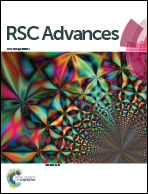Ag@TiO2NPs/PU composite fabric with special wettability for separating various water–oil emulsions†
Abstract
In the present study, Ag@TiO2 nanoparticles (NPs) were successfully synthesized by a hydrothermal method. Then the fabric (treated by dielectric barrier discharge (DBD) plasma and alkali desizing) was sprayed by solutions of polyurethane (PU) adhesive and as-prepared Ag@TiO2NPs in sequence for constructing a robust multi-level structure. Afterwards, the durable superhydrophilic and underwater superoleophobic coatings were obtained on the fabric surface. With further octadecyl trichlorosilane (OTS) modification, the wetting behaviour of the coating was transferred to superhydrophobicity and superoleophilicity. Observations showed that both cotton fabrics exhibited excellent superwetting properties and antimicrobial activities even after experiencing repeated rinsing by water or oil, abrasion with the original cotton fabric or sand paper, and in chemical stability tests in a base and acid, etc. Moreover, the two types of Ag@TiO2NPs/PU composite fabrics could successfully serve as filtering membranes for the fine reclamation of water or oil from their emulsion mixtures, which demonstrated high selectivity and efficiency, offering the theoretical foundation to extend the range of practical applications for textiles.



 Please wait while we load your content...
Please wait while we load your content...